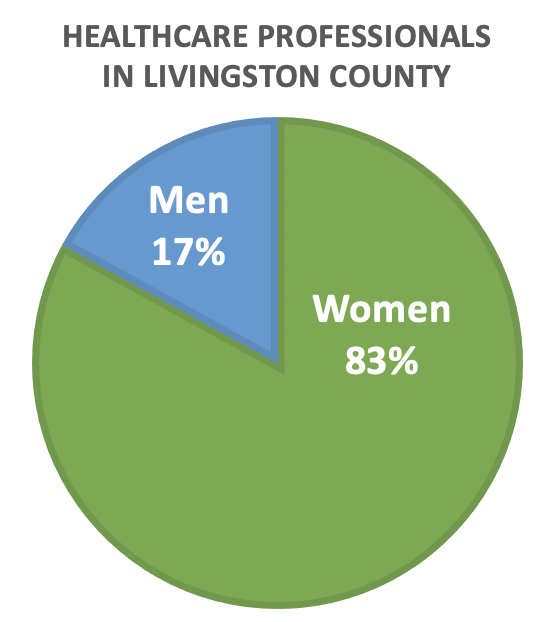In the industry-agnostic “race for talent,” companies are pushed to creative recruiting approaches to make competitive hiring decisions and fill open positions. This trend is particularly evident in the healthcare industry, as services continue to grow in demand and changes in technology require up-to-date training and adaptive workers. Data and research on the demographics of talent and future employment projections help human resources professionals and administrative staff determine where and how recruiting efforts should be focused. The following analysis uses data to provide guidance practitioners can use to address the talent shortage in healthcare workers.
Who works in
healthcare in Livingston County?
The healthcare industry consists of hundreds of potential
occupations, many of which require certifications or advanced degrees.

Eighty-three percent of healthcare workers in Livingston
County are female; of the top fifteen healthcare occupations, the number of men
exceeded women in only two categories: Dentists and Physicians and Surgeons.
Sixty-seven percent of healthcare workers are between the ages
of 25 – 54, with the highest concentration of employees between the ages of 25
– 34. There is a large variation in the average age of healthcare workers
depending on the occupation. This is likely due to the different training and
credentials required for different occupations.
While 96 percent of Livingston County residents are white,
82 percent of healthcare workers in Livingston County are white, indicating
that healthcare is a field that attracts diverse candidates.
What are the most
in-demand occupations and industries in healthcare?
An analysis of job posting data reveals the top in-demand healthcare
occupations and sub-industries. This information is helpful for recruiters to
understand what level of market competition they are facing.
In Livingston County, the top in-demand healthcare occupations (based on the number of job postings) are registered nurses, medical assistants, pharmacy technicians, nursing assistants, and home health aids. These five occupations make up 56 percent of all healthcare related job postings in Livingston County.
Using job posting data, an analysis of the top
sub-industries in healthcare reveals that general medical and surgical hospitals,
home health care services, employment placement agencies, office administrative
services, and colleges, universities, and professional schools. These five
sub-industry categories make up 48 percent of all job postings in the
healthcare industry
How many graduates
are part of Livingston County’s healthcare talent pool?
Job posting data and current employment data helps to reveal
what skills and credentials are needed in Livingston County. This information
is valuable to human resources professionals who invest in workforce training
and recruit from local colleges and universities.

Home health aides is one of the top occupations by number of
job postings, and also one of the top occupations by number of current
employees. Often, jobs as home health care aides do not require a certification
and recruiting can be done using a broader range of potential candidates.
However, other top occupations from this analysis do reveal
a need to work with local training providers to ensure a consistent talent
pipeline. Given demand for Registered Nurses, Physical Therapists, Medical
Assistants, Pharmacy Technicians, Licensed Practical Nurses, and Nursing
Assistants, local training for these programs is critical.
Understanding the talent pipeline that exists will help to determine
recruitment targets and workforce availability for Human Resource Professionals.
Within a 50-mile radius of Livingston County, there were 158
Physical Therapy graduates, of which 88 graduated from the University of
Michigan Flint, 37 graduated from Oakland University, and 33 graduated from
Wayne State University.
In the same geographical area, there were 3,410 graduates of
Registered Nursing programs. Of these graduates, 1,176 completed an associate
degree and 2,085 completed a bachelor’s degree (the remaining 149 students
finished their education with a graduate degree or higher). Of the schools
offering programs for registered nurses, the most graduates came from Oakland
University (392 graduates), University of Michigan-Flint (343 graduates),
University of Detroit Mercy (342 graduates), Michigan State University (278
graduates), and Eastern Michigan University (262 graduates). Henry Ford College
graduated the largest number of registered nurses with an associate degree (232
graduates).
For pharmacy technicians, there were only 39 graduates
within a 50-mile radius of Livingston County — indicating that there is likely
high demand for additional pharmacy technician training locally (there were 142
job postings for pharmacy technicians in 2018). Of the 39 Pharmacy technician
graduates, 36 graduated from Baker College, two graduated from Oakland
Community College, and one student graduated from Jackson College.
There were 166 graduates with medical assistant
certifications from colleges/universities within a 50-mile radius of Livingston
County. This data does not include medical assistant certifications through
training centers, such as Ross Medical Education. Of the 166 graduates, 114 are
alumni of Baker College, 31 attended Macomb Community College, 16 attended
Jackson College, and two graduates were from Oakland Community College.
(Data is not available for licensed practical nurses and nursing
assistants.)
Conclusion
Healthcare continues to be one of Livingston County’s most
in-demand industries, even as employers face challenges with burnout,
retention, and recruitment. While there were 1,779 job postings for healthcare
workers in 2018, many specific occupational categories did not produce enough
talent to fill local vacancies. It is important for employers to take a
proactive, data-driven approach in their recruitment strategies to find the
best talent to work for them.
The post Recruiting Healthcare Talent in Livingston County appeared first on Ann Arbor SPARK.
Source: SPARK







